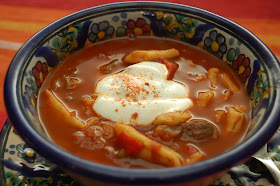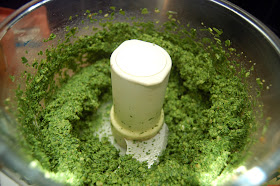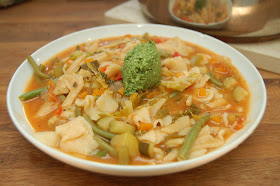If you're looking for something warming and tasty for your dinner this week you really should try out this recipe for goulash. I don't own a slow cooker but I'm sure you could easily make the soup/stew in it and add the noodles just before eating. It is well worth
making your own egg noodles to go with this dish. They're really easy and have a lovely light texture that is perfect with the goulash. You could also add these egg noodles to any other soup or stew, they'd be particularly good in a chicken noodle soup (I'll post a recipe soon).

Ingredients
400 g stewing beef cut into bite sized pieces
2 medium-sized onions, finely chopped
2 tbsp oil
3 tbsp Hungarian Paprika (I didn’t have any so put together my own mix of 2 tbsp regular paprika, 1 tbsp sweet smoked paprika plus 1 tsp hot smoked paprika because I like a bit of a kick in my food)
1/2 tsp caraway seeds
2 cloves of garlic, minced, crushed or finely chopped
500ml beef stock
500ml water
1 green pepper, de-seeded and diced
1 red pepper, de-seeded and diced
1 x 400g tin of chopped tomatoes
1-2 carrots, peeled and diced
3 medium potatoes peeled and cut into chunks
salt and pepper to taste
Extra 1 tbsp. paprika
1 portion homemade egg noodles
1. Heat a heavy based saucepan over a medium high heat and add 2 tbsp oil. Saute the onions until they are translucent. Add the beef and colour on all sides.
2. Chuck in the paprika, caraway and garlic. Stir thoroughly so all the meat is well covered. The base of your sauce pan might get a bit gunked up at this stage. Don’t panic, just make sure it isn’t burning.
3. Next add the carrots and pepers, give them a good stir then add the tinned, chopped tomatoes. Give everything another good stir and break up the sticky bits from the bottom of the pan with your spoon.
4. Add the beef stock and water and continue to heat until just boiling. Now turn the heat down as low as you can, cover the pan and leave to cook for around an hour until the beef is completely cooked and almost falling apart.
5. Next add the potatoes and continue to simmer until they are soft and cooked through.
6. Season to taste and stir through the extra tbsp. of paprika.
7. You can serve the goulash as it is now with a dollop of sour cream or crème fraiche and some crusty bread or you can add some
homemade egg noodles.




















































